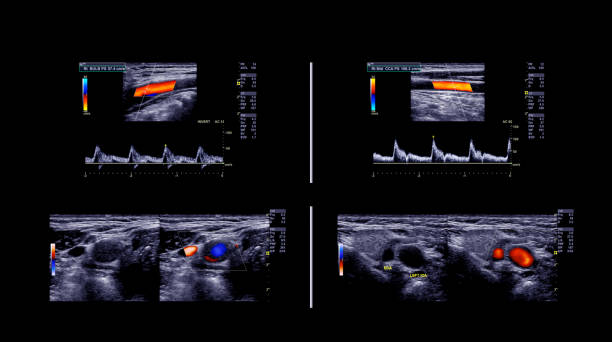In the realm of medical diagnostics, ultrasound scans have revolutionized the way healthcare professionals examine and analyze various conditions. Among the different types of ultrasound scans, Colour Doppler, Duplex Doppler, and Triplex Doppler are widely utilized techniques. In this article, we will delve into these advanced ultrasound modalities, exploring their significance, applications, and key differentiating factors.
Understanding Colour Doppler Ultrasound:
Colour Doppler ultrasound, also known as Color Flow Imaging (CFI), is a non-invasive imaging technique that allows healthcare practitioners to visualize and evaluate blood flow patterns in real-time. By applying the Doppler effect, which measures frequency shifts of reflected sound waves, Colour Doppler provides valuable information about the direction, velocity, and presence of abnormalities within blood vessels.
When performing a Colour Doppler ultrasound, a transducer emits sound waves at a specific frequency range. As the waves encounter moving blood cells, they bounce back, with their frequency altered based on the velocity of the blood flow. The system then processes this information and generates a color-coded image, where different colors represent the flow direction and velocity.
Applications of Colour Doppler Ultrasound:
-
Vascular Assessments: Colour Doppler ultrasound aids in the assessment of blood vessel conditions, such as Peripheral Arterial Disease (PAD), deep vein thrombosis (DVT), and varicose veins. It helps to identify blockages or abnormalities detectable through altered blood flow patterns.
-
Obstetrics and Gynecology: In prenatal care, Colour Doppler ultrasound assists in determining placental function, evaluating fetal circulation, and identifying potential complications like placental insufficiency or umbilical cord abnormalities.
-
Cardiology: Colour Doppler plays a crucial role in assessing heart conditions by monitoring blood flow through major arteries and veins, identifying issues like valve abnormalities, heart murmurs, and congestive heart failure.
Understanding Duplex Doppler Ultrasound:
Duplex Doppler ultrasound combines B-mode grayscale imaging with traditional Doppler capabilities. Essentially, it allows clinicians to simultaneously visualize anatomical structures while assessing blood flow patterns. This integration helps to provide a comprehensive assessment and facilitate accurate diagnosis.
The Benefits of Duplex Doppler Ultrasound:
-
Enhanced Accuracy: By combining anatomical imaging with blood flow data, Duplex Doppler enhances diagnostic accuracy, allowing healthcare professionals to better evaluate conditions like deep vein thrombosis, carotid artery stenosis, and peripheral arterial occlusive disease.
-
Real-Time Monitoring: Duplex Doppler provides real-time monitoring during surgical or interventional procedures involving blood vessels, enabling immediate feedback and ensuring optimal outcomes.
Understanding Triplex Doppler Ultrasound:
Triplex Doppler ultrasound takes the capabilities of Duplex Doppler one step further by adding pulsed wave Doppler to the imaging process. This additional feature enables healthcare professionals to assess blood flow in more detail, providing valuable insights into the velocity, waveform patterns, and resistance indices of blood vessels.
The Advantages of Triplex Doppler Ultrasound:
-
Detailed Vascular Mapping: Triplex Doppler allows practitioners to capture more comprehensive data about the vasculature, facilitating precise anatomical mapping and aiding in the detection of stenosis, occlusions, or aneurysms.
-
Quantitative Assessments: Triplex Doppler provides clinicians with quantitative measurements, such as peak systolic velocity and resistive indices, enabling them to monitor disease progression or response to treatment accurately.
Conclusion:
Ultrasound scans have become indispensable tools in modern medical practice, allowing healthcare professionals to visualize and assess various conditions effectively. Colour Doppler, Duplex Doppler, and Triplex Doppler techniques have significantly expanded the diagnostic capabilities of ultrasound imaging, particularly in assessing blood flow patterns and vascular health. By understanding and utilizing these advanced modalities, medical professionals can enhance patient care, improve treatment planning, and expedite accurate diagnoses.
Keywords:
- Ultrasound scan techniques
- Colour Doppler ultrasound
- Duplex Doppler ultrasound
- Triplex Doppler ultrasound
- Importance of Doppler ultrasound
Title:
- Exploring the Varied Applications of Doppler Ultrasound Scans
- An In-Depth Look at Colour Doppler, Duplex Doppler, and Triplex Doppler Ultrasound
- Understanding the Significance of Doppler Ultrasound in Medical Diagnostics
- The Role of Doppler Ultrasound in Vascular Health Assessment
- Unraveling the Complexity of Doppler Ultrasound: Colour, Duplex, and Triplex Doppler Explained


